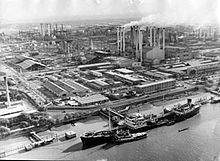Abadan Refinery
Oil refinery in Abadan, Iran From Wikipedia, the free encyclopedia
Oil refinery in Abadan, Iran From Wikipedia, the free encyclopedia
The Abadan refinery (Persian: پالایشگاه آبادان Pālāyeshgāh-e Ābādān) is an oil refinery in Abadan, Iran near the coast of the Persian Gulf.
Built by the Anglo-Persian Oil Company (later BP) on the basis of a lease obtained in 1909,[1] it was completed in 1912 as a pipeline terminus, and was one of the world's largest oil refineries. In 1927, oil exports from Abadan totalled nearly 4.5 million tons.[1]

Its nationalisation in 1951 prompted the Abadan Crisis and ultimately the toppling of the democratically elected[2] prime minister Mossaddegh.[3] The refinery was largely destroyed in September 1980 by Iraq during the initial stages of the Iraqi invasion of Iran's Khuzestan province, triggering the Iran–Iraq War.[citation needed] It had a capacity of 635,000 b/d in 1980 and formed a refinery complex with important petrochemical plants. Its capacity started to bounce back after the war ended in 1988, and was listed in 2013 as 429,000 barrels per day (68,200 m3/d) of crude oil.[4]
In December 2017, Sinopec signed a US$1 billion deal to expand the Abadan refinery.[5] Work on the second phase of the project was suspended in March 2020 due to the COVID-19 pandemic in Iran.[6]
Seamless Wikipedia browsing. On steroids.
Every time you click a link to Wikipedia, Wiktionary or Wikiquote in your browser's search results, it will show the modern Wikiwand interface.
Wikiwand extension is a five stars, simple, with minimum permission required to keep your browsing private, safe and transparent.